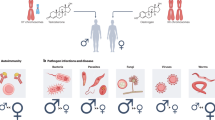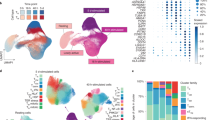Abstract
Women develop chronic inflammatory autoimmune diseases more often than men. The mechanisms causing the increased susceptibility are incompletely understood. Chronic immune stimulation characterizes many autoimmune disorders. We hypothesized that repeated stimulation may cause a different T-cell response in women than in men. Microarrays were used to compare gene expression in T cells from healthy men and women with and without repeated stimulation. Four days after a single stimulation, only 25% of differentially expressed, gender-biased genes were expressed at higher levels in women. In contrast, after restimulation, 72% were more highly expressed in women. Immune response genes were significantly over-represented among the genes upregulated in women and among the immune response genes, the inflammatory/cytotoxic effector genes interferon-γ (IFN-γ), lymphotoxin β (LTβ), granzyme A (GZMA), interleukin-12 receptor β2 (IL12Rβ2), and granulysin (GNLY) were among those overexpressed to the highest degree. In contrast, IL17A was the only effector gene more highly expressed in men. Estrogen response elements were identified in the promoters of half the overexpressed immune genes in women, and in <10% of the male-biased genes. The differential expression of inflammatory/cytotoxic effector molecules in restimulated female T cells may contribute to the differences in autoimmune diseases between women and men.
This is a preview of subscription content, access via your institution
Access options
Subscribe to this journal
Receive 6 digital issues and online access to articles
$119.00 per year
only $19.83 per issue
Buy this article
- Purchase on Springer Link
- Instant access to full article PDF
Prices may be subject to local taxes which are calculated during checkout



Similar content being viewed by others
References
Ober C, Loisel DA, Gilad Y . Sex-specific genetic architecture of human disease. Nat Rev Genet 2008; 9: 911–922.
Roubinian JR, Talal N, Greenspan JS, Goodman JR, Siiteri PK . Effect of castration and sex hormone treatment on survival, anti-nucleic acid antibodies, and glomerulonephritis in NZB/NZW F1 mice. J Exp Med 1978; 147: 1568–1583.
Li J, McMurray RW . Effects of estrogen receptor subtype-selective agonists on autoimmune disease in lupus-prone NZB/NZW F1 mouse model. Clin Immunol 2007; 123: 219–226.
Huang JL, Yao TC, See LC . Prevalence of pediatric systemic lupus erythematosus and juvenile chronic arthritis in a Chinese population: a nation-wide prospective population-based study in Taiwan. Clin Exp Rheumatol 2004; 22: 776–780.
Uekert SJ, Akan G, Evans MD, Li Z, Roberg K, Tisler C et al. Sex-related differences in immune development and the expression of atopy in early childhood. J Allergy Clin Immunol 2006; 118: 1375–1381.
Invernizzi P, Pasini S, Selmi C, Miozzo M, Podda M . Skewing of X chromosome inactivation in autoimmunity. Autoimmunity 2008; 41: 272–277.
Sawalha AH, Jeffries M, Webb R, Lu Q, Gorelik G, Ray D et al. Defective T-cell ERK signaling induces interferon-regulated gene expression and overexpression of methylation-sensitive genes similar to lupus patients. Genes Immun 2008; 9: 368–378.
Yung RL, Quddus J, Chrisp CE, Johnson KJ, Richardson BC . Mechanism of drug-induced lupus. I. Cloned Th2 cells modified with DNA methylation inhibitors in vitro cause autoimmunity in vivo. J Immunol 1995; 154: 3025–3035.
Richardson B . Primer: epigenetics of autoimmunity. Nat Clin Pract Rheumatol 2007; 3: 521–527.
Fox DA . The role of T cells in the immunopathogenesis of rheumatoid arthritis: new perspectives. Arthritis Rheum 1997; 40: 598–609.
Korman BD, Kastner DL, Gregersen PK, Remmers EF . STAT4: genetics, mechanisms, and implications for autoimmunity. Curr Allergy Asthma Rep 2008; 8: 398–403.
Murphy HS, Sun Q, Murphy BA, Mo R, Huo J, Chen J et al. Tissue-specific effect of estradiol on endothelial cell-dependent lymphocyte recruitment. Microvasc Res 2004; 68: 273–285.
Lu Q, Wu A, Tesmer L, Ray D, Yousif N, Richardson B . Demethylation of CD40LG on the inactive X in T cells from women with lupus. J Immunol 2007; 179: 6352–6358.
Yang X, Schadt EE, Wang S, Wang H, Arnold AP, Ingram-Drake L et al. Tissue-specific expression and regulation of sexually dimorphic genes in mice. Genome Res 2006; 16: 995–1004.
Korn T, Oukka M, Kuchroo V, Bettelli E . Th17 cells: effector T cells with inflammatory properties. Semin Immunol 2007; 19: 362–371.
Damian DL, Patterson CR, Stapelberg M, Park J, Barnetson RS, Halliday GM . UV radiation-induced immunosuppression is greater in men and prevented by topical nicotinamide. J Invest Dermatol 2008; 128: 447–454.
Ellegren H, Parsch J . The evolution of sex-biased genes and sex-biased gene expression. Nat Rev Genet 2007; 8: 689–698.
Reinius B, Saetre P, Leonard JA, Blekhman R, Merino-Martinez R, Gilad Y et al. An evolutionarily conserved sexual signature in the primate brain. PLoS Genet 2008; 4: e1000100.
Zhang Y, Sturgill D, Parisi M, Kumar S, Oliver B . Constraint and turnover in sex-biased gene expression in the genus Drosophila. Nature 2007; 450: 233–237.
Lockshin MD . Sex ratio and rheumatic disease. Autoimmun Rev 2002; 1: 162–167.
Ansar Ahmed S, Penhale WJ, Talal N . Sex hormones, immune responses, and autoimmune diseases. Mechanisms of sex hormone action. Am J Pathol 1985; 121: 531–551.
Pernis AB . Estrogen and CD4+ T cells. Curr Opin Rheumatol 2007; 19: 414–420.
Bisset LR, Lung TL, Kaelin M, Ludwig E, Dubs RW . Reference values for peripheral blood lymphocyte phenotypes applicable to the healthy adult population in Switzerland. Eur J Haematol 2004; 72: 203–212.
McKinstry KK, Strutt TM, Swain SL . The effector to memory transition of CD4 T cells. Immunol Res 2008; 40: 114–127.
Acknowledgements
We thank Ms Cindy Bourke for her expert secretarial assistance. This work was supported by PHS Grants AR42525, AG25877 and ES015214, and a Merit grant from the Department of Veterans Affairs.
Author information
Authors and Affiliations
Corresponding author
Additional information
Supplementary Information accompanies the paper on Genes and Immunity website (http://www.nature.com/gene)
Rights and permissions
About this article
Cite this article
Hewagama, A., Patel, D., Yarlagadda, S. et al. Stronger inflammatory/cytotoxic T-cell response in women identified by microarray analysis. Genes Immun 10, 509–516 (2009). https://doi.org/10.1038/gene.2009.12
Received:
Revised:
Accepted:
Published:
Issue Date:
DOI: https://doi.org/10.1038/gene.2009.12
Keywords
This article is cited by
-
Mechanisms and consequences of sex differences in immune responses
Nature Reviews Nephrology (2024)
-
Proteins in pregnant swine serum promote the African swine fever virus replication: an iTRAQ-based quantitative proteomic analysis
Virology Journal (2023)
-
Burden of influenza A (H1N1)pdm09 infection among tuberculosis patients: a prospective cohort study
BMC Infectious Diseases (2023)
-
Sex hormones in SARS-CoV-2 susceptibility: key players or confounders?
Nature Reviews Endocrinology (2023)
-
Biological differences underlying sex and gender disparities in bladder cancer: current synopsis and future directions
Oncogenesis (2023)



